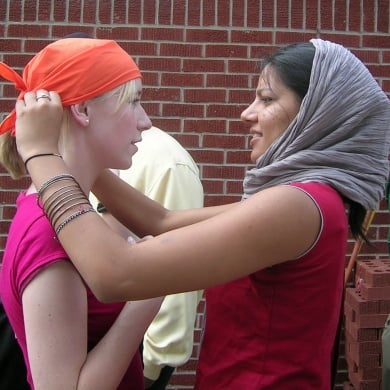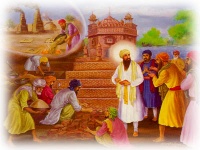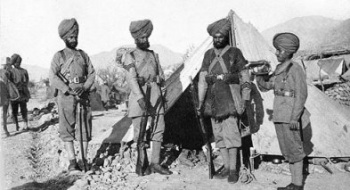Main Page
|
|
Introduction · Searching · Editing · Questions · Help |
|
On September 12, the Sikhs worldwide will remember with honor the supreme sacrifice of their brave comrades who for the security and safeguard of their country willingly laid down their lives. The bravery of these soldiers was inspired by the heart piercing message of their tenth Guru, Guru Gobind Singh. .....More  See www.millsaps.edu Ardas is a unique prayer; It's an appeal to Waheguru; a way to address and petition the Almighty; to gain spiritual energy; to connect with God. It is a very well-known Sikh prayer that was not written in its entirety by the Gurus. The Ardas is an ever changing plea, the contents of which depend on local concerns and personal issues. The word Ardĝs ( ਅਰਦਾਸ ) is derived from Persian word 'Arazdashat', meaning a request, a supplication, a prayer, a petition or an address to a superior authority. The power that this single prayer possesses is astonishing. Starting with "Pritham bhagautee simar kai, Gur Nanak laee dhiaa-e" and ending with "Naanak naam charhdee kalaa, tayray bhaanay Sarbat da bhala". The ardas encompasses so many Sikh and Humanistic values. It is more than just a prayer; it is a new concept of therapy for the elevation of the human spirit, mind and body. The Ardas is usually done standing up with folded hands. The beginning of the Ardas is strictly set by the tenth Sikh Guru, Guru Gobind Singh. When it comes to the conclusion of this prayer, the devotee uses the word Waheguru .....More  Khanda – a symbol of disciplined conduct Rehat Maryada is the Sikh Code of Conduct by which all Sikhs need to regulate their lives and to control their needs and actions. This Code of Conduct is the guideline by which a Sikh should live his or her life. The main theme through this regulation is the reliance on a "disciplined life" – a Sikh is bound by the Guru to lead a simple life where the mind has a control over the various desires and urges that are trying to overpower the person's mind. The Guru tells us that for a "pure" Sikh, "True are his actions; true are his ways." (SGGS p283) and "Those who speak are liberated, and those who listen are liberated; those who keep the Rehat (discipled code), are not reincarnated again." (SGGS p1230). In 1950 the SGPC formulated a formal Code of Conduct to provide guidelines for all Sikh individuals and communities around the world. Its implementation has resulted in a high level of uniformity in the religious and social practices of Sikhism. This Rehat Maryada provides some direct and effective guideline for a committed Sikh…....Continued  Gurdwara under construction during the time of the Gurus with the donations from the Sangat Dasvandh or Dasaundh, literally means a "tenth part" and refers to the practice among Sikhs of contributing in the name of the Guru one-tenth of their earnings towards the common resources of the community. This is their religious obligation — a religious requirement or duty; a form of seva or humble service which is highly valued in the Sikh system. The concept of dasvandh was implicit in Guru Nanak’s own Gurbani in the line: "ਘਾਲਿ ਖਾਇ ਕਿਛੁ ਹਥਹੁ ਦੇਇ ॥ ਨਾਨਕ ਰਾਹੁ ਪਛਾਣਹਿ ਸੇਇ ॥੧॥ One who works for what he eats, and gives some of what he has - O Nanak, he knows the Path (1)" (SGGS p 1245) The idea of sharing and giving is symbolised by the institutions of langar (community kitchen) for the sangat (holy assembly) that the Guru has established. In the time of Guru Amar Das, Nanak III, a formal structure for channelizing Sikh religious giving was evolved. The Guru set up 22 manjis or districts in different parts of the country, each placed under the charge of a pious Sikh who, besides preaching Guru Nanak's word, looked after the sangats within his/her jurisdiction and transmitted the disciple’s offerings to the Guru. .....More |
Newsfeed error - investigating. Back soon. <rss>http://www.sikhnet.com/sikhnet/NEWS.nsf/sikhnetnews.rss</rss>
Read More News
News Updated Daily 11am-12pm MDT Mon-Friday |
| Su | Mo | Tu | We | Th | Fr | Sa |
|---|---|---|---|---|---|---|
| September 2006 | 1 First Parkash Sri Guru Granth Sahib | 2 | ||||
| 3 | 4 | 5 | 6 | 7 | 8 | 9 |
| 10 | 11 | 12 Battle of Saragarhi | 13 | 14 | 15 Assu ->16 Gur Gadi Guru Arjan Dev & Guru Ram Das | 16 Joti Jot Guru Amar Das & Guru Ram Das |
| 17 | 18 Gur Gadi Guru Angad Dev | 19 | 20 | 21 |
22 Joti Jot Guru Nanak Dev |
23 |
| 24 | 25 | 26 | 27 | 28 | 29 | 30 |
- This version of SikhiWiki, started at 17:08 on 23 Feb 2005. Articles contains many new images which help bring home clearly the message of our Gurus.
- You can view the most popular pages and the newest pages available at SikhiWiki.
| Popular Articles on Sikhi Wiki |
|
Mool Mantar | Japji | Sikhism | Dasam Granth | Kirtan | Beliefs | Bani | Gurus | SGGS | Bhai Manjh | Vegetarianism | Bhagat Sain | Bhagat Dhanna | Today | Blogs |


